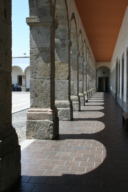
 |
|
|
Join us on
Talk tequila:Join the discussion forum to ask questions, make comments, vote in polls, rate your favourite tequilas or simply meet other tequila aficionados.
Tequila sips:Agave nectar was known and widely used among the Pre-Columbian cultures. Along with honey, it was used a flavouring for several dishes, and as a sweetener when drinking chocolate. Both were highly valued and traded extensively throughout Mesoamerica. These products augmented other Mesoamerican foodstuffs: maize and posolli gruels and their atolli and pinolli drinks. There is evidence that sweetmeat dessert-like substances made with toasted squash seeds or popped amaranth seeds and boiled agave syrup or honey were made and given as gifts and used as ritual offerings.
Quick links
Updated May, 2011 |
Visiting Tequila Country
Getting to the land of the blue agave is easier every year. Many airlines fly into Guadalajara from around the world, and the tequila regions are a mere 1-2 hours away. There are buses from Guadalajara that go to each zone daily (take a taxi to the new bus station and find the appropriate bus). A taxi to Tequila from Guadalajara airport was about $80 USD in 2006, more than double that to Arandas.
 You can also rent a car and drive to both regions long the well-marked Mexican highways. Be forewarned: the traffic in Guadalajara is a challenge for anyone not used to Mexican driving. Once outside Guadalajara, Tequila is about 45 minutes' drive away. There are two highways: the slower two-lane free highway which runs through Arenal and Amatitan before it reaches Tequila, and the faster toll highway, which bypasses the smaller towns and requires several payments before the exit to Tequila.
 Tequila is considered a day trip, a jaunt from Guadalajara,
for many Mexicans and foreigners. Tour buses in the city offer low-cost
day trips to Tequila, with one or more distillery tours thrown in. Tequila is considered a day trip, a jaunt from Guadalajara,
for many Mexicans and foreigners. Tour buses in the city offer low-cost
day trips to Tequila, with one or more distillery tours thrown in.
The Tequila Express is another popular weekend excursion; a two-hour train ride to Amatitan with music and dance performance, is followed by and a tour of the Herradura factory at Hacienda San Jose del Refugio, that dates to 1820. The cost for the train trip is about $70 USD and tickets are available from Ticketmaster's Mexico outlet.
 In Tequila itself you can go on
several inexpensive bus or walking tours of the local distilleries. There are
usually ticket sellers in the plaza and zocalo. But you can also simply
go to the distilleries and pay for a tour, or just ask to visit. While
tours were a rarity a decade ago, they have become part of Tequila's
growing tourist business today. However, while the larger distillers may
have regular tours, smaller companies may only allow them by
pre-arrangement and some are still not comfortable with the idea of
allowing visitors onto their premises. In Tequila itself you can go on
several inexpensive bus or walking tours of the local distilleries. There are
usually ticket sellers in the plaza and zocalo. But you can also simply
go to the distilleries and pay for a tour, or just ask to visit. While
tours were a rarity a decade ago, they have become part of Tequila's
growing tourist business today. However, while the larger distillers may
have regular tours, smaller companies may only allow them by
pre-arrangement and some are still not comfortable with the idea of
allowing visitors onto their premises.
However, while Guadalajara has many facilities for international visitors, since most of the tequila-producing towns are small and not on the popular tourist trails, they lack a lot of amenities. There are small but clean and attractive hotels in Arandas and Tequila.  Outside those towns, however, facilities tend to be more spartan but prices are very reasonable. Check for rooms and availability
before you travel. I have stayed at the Mision Tequillan in Tequila
(telephone +52-374-742-3233) and the Hotel Santa Barbara in Arandas
(52-348-783-3737) and can highly recommend both of them. Outside those towns, however, facilities tend to be more spartan but prices are very reasonable. Check for rooms and availability
before you travel. I have stayed at the Mision Tequillan in Tequila
(telephone +52-374-742-3233) and the Hotel Santa Barbara in Arandas
(52-348-783-3737) and can highly recommend both of them.Since UNESCO added the tequila-producing regions to their list of World Heritage Sites, Tequila has been seeing more tourists:
    If at all possible to fit it in to your travel schedule, spend at least a day visiting Guadalajara. It is a beautiful city, Mexico's second largest, with many plazas, colonial buildings, art galleries, wide streets, a fascinating mercado and great places to eat and shop. For some personal reminiscences of the area, read the tour 2006 and tour 2007 pages.
Sources:
|
||
